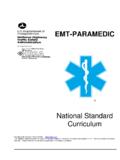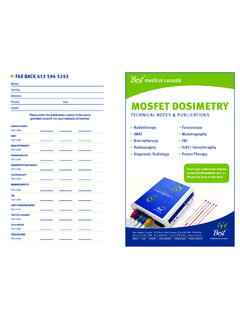Transcription of Hospital emergency response checklist - …
1 Hospital emergency response checklist An all-hazards tool for Hospital administrators andemergency managersSupported by The European Commission Health Programme2008-2013 Together for HealthHospital emergency response checklist An all-hazards tool for Hospital administratorsand emergency managersHospitals play a critical role in providing communities with essential medical care during all types of disaster. De-pending on their scope and nature, disasters can lead to a rapidly increasing service demand that can overwhelm the functional capacity and safety of hospitals and the health-care system at large. The World Health Organization Regional Office for Europe has developed the Hospital emergency response checklist to assist Hospital administrators and emergency managers in responding effectively to the most likely disaster scenarios. This tool comprises current Hospital -based emergency management principles and best practices and integrates priority action required for rapid, effective response to a critical event based on an all-hazards approach.
2 The tool is structured according to nine key components, each with a list of priority action to support Hospital managers and emergency planners in achieving: (1) continuity of essential services; (2) well-coordinated implementation of Hospital operations at every level; (3) clear and accurate internal and external communication; (4) swift adaptation to increased demands; (5) the effective use of scarce resources; and (6) a safe environment for health-care workers. References to selected supplemental tools, guidelines and other applicable resources are provided. The principles and recommendations included in this tool may be used by hospitals at any level of emergency preparedness. The checklist is intended to complement existing multisectoral Hospital emergency management plans and, when possible, augment standard operating procedures during non-crisis situations. This document has been produced with the financial assistance of the European Union.
3 The views expressed herein can in no way be taken to reflect the official opinion of the European Union. KeywordsEMERGENCY MEDICAL SERVICESEMERGENCY SERVICE, HOSPITALDELIVERY OF HEALTH CAREHOSPITAL PLANNING Address requests about publications of the WHO Regional Office for Europe to:PublicationsWHO Regional Office for EuropeScherfigsvej 8DK-2100 Copenhagen , DenmarkAlternatively, complete an online request form for documentation, health information, or for permission to quote or translate, on the Regional Office web site ( ).Abstract World Health Organization 2011 All rights reserved. The Regional Office for Europe of the World Health Organization welcomes requests for permission to reproduce or translate its publications, in part or in designations employed and the presentation of the material in this publication do not imply the expression of any opinion whatsoever on the part of the World Health Organization concerning the legal status of any country, territory, city or area or of its authorities, or concerning the delimitation of its frontiers or boundaries.
4 Dotted lines on maps represent approximate border lines for which there may not yet be full mention of specific companies or of certain manufacturers products does not imply that they are endorsed or recommended by the World Health Organization in preference to others of a similar nature that are not mentioned. Errors and omissions excepted, the names of proprietary products are distinguished by initial capital reasonable precautions have been taken by the World Health Organization to verify the information contained in this publication. However, the pub-lished material is being distributed without warranty of any kind, either express or implied. The responsibility for the interpretation and use of the material lies with the reader. In no event shall the World Health Organization be liable for damages arising from its use. The views expressed by authors, editors, or expert groups do not necessarily represent the decisions or the stated policy of the World Health PageMain authors.
5 6 Glossary ..7 Introduction ..9 Key component 1. Command and control ..10 Key component 2. Communication ..12 Key component 3. Safety and security ..13 Key component 4. Triage ..14 Key component 5. Surge capacity ..15 Key component 6. Continuity of essential services ..16 Key component 7. Human resources ..17 Key component 8. Logistics and supply management ..19 Key component 9. Post-disaster recovery ..20 References ..21 Recommended reading ..22 Contents6Dr Brian S. SorensenAttending Physician, department of emergency Medicine, brigham and women s HospitalAssociate Faculty, Harvard Humanitarian Initiative Instructor of Medicine, Harvard Medical SchoolBostonUnited States of AmericaDr Richard D. ZaneVice Chair, department of emergency Medicine, brigham and women s HospitalAssociate Professor of Medicine, Harvard Medical SchoolBostonUnited States of AmericaMr Barry E. WanteDirector of emergency Management, Center for emergency PreparednessBrigham and women s HospitalBostonUnited States of AmericaDr Mitesh B.
6 RaoEmergency Physician, Yale-New Haven HospitalNew Haven, ConnecticutUnited States of America Dr Michelangelo BortolinEmergency Physician, Torino emergency Medical ServicesAdjunct Faculty, Harvard-affiliated Disaster Medicine FellowshipTorinoItalyDr Gerald RockenschaubProgramme Manager, Country emergency Preparedness ProgrammeWHO Regional Office for EuropeCopenhagenDenmarkMain authors7 CapacityThe combination of all the strengths, attributes and resources available within an organization that can be used to achieve agreed goals (1).Command and controlThe decision-making system responsible for activating, coordinating, implementing, adapting and terminating a pre-established response plan (2).Contingency planningA process that analyses potential events or emerging situations that might threaten society or the environment and establishes arrangements that would enable a timely, effective and appropriate response to such events should they occur.
7 The events may be specific, categorical, or all-hazard. Contingency planning results in organized and coordi-nated courses of action with clearly identified institutional roles and resources, information processes and operational arrangements for specific individuals, groups or departments in times of need (1).Critical eventAny event in connection with which a Hospital finds itself unable to deliver care in the customary fashion or to an ac-cepted standard, event resulting in a mismatch of supply (capacity, resources, infrastructure) and demand (patients), and requiring the Hospital to activate contingency measures to meet demand. DisasterAny event or series of events causing a serious disruption of a community s infrastructure often associated with widespread human, material, economic, or environmental loss and impact, the extent of which exceeds the ability of the affected community to mitigate using existing resources (1).
8 EmergencyA sudden and usually unforeseen event that calls for immediate measures to mitigate impact (3). emergency response planA set of written procedures that guide emergency actions, facilitate recovery efforts and reduce the impact of an emergency action planA document that guides operational activities of the Incident Command System during the response phase to a particular incident. The document contains the overall incident objectives and strategy, general tactical actions, and supporting information to enable successful completion of objectives (4).Incident command groupA multidisciplinary body of the incident command system, which provides the overall technical leadership and over-sight for all aspects of crisis management, coordinates the overall response , approves all action, response and mitiga-tion plans, and serves as an authority on all activities and decisions. Incident command systemThe designated system of command and control, which includes a combination of facilities, equipment, personnel, procedures, and means of communication, operating within a common organizational structure designed to aid in the management of resources for emergency incidents (4).
9 Glossary8 Memorandum of understandingA formal document embodying the firm commitment of two or more parties to an undertaking; it sets out the general principles of the commitment but falls short of constituting a detailed contract or agreement (5).Mutual-aid agreementAn agreement between agencies, organizations and jurisdictions, which provides a mechanism whereby emergency assistance in the form of personnel, equipment, materials and other associated services can be obtained quickly. The primary objective of the agreement is to facilitate the rapid, short-term deployment of emergency support prior to, dur-ing and after an incident (6).PolicyA formally advocated statement or understanding adopted to direct a course of action, including planning, command and control, preparedness, mitigation, response and recovery (7).Preparedness The knowledge and capacities developed by governments, professional response and recovery organizations, com-munities and individuals to effectively anticipate, respond to and recover from the impacts of likely, imminent, or cur-rent hazardous events or conditions (1).
10 RecoveryRestoring or improving the functions of a facility affected by a critical event or disaster through decisions and action taken after the event (8).ResourcesThe personnel, finances, facilities and major equipment and supply items available or potentially available for assign-ment to incident provision of emergency services and public assistance during or immediately after a disaster in order to save lives, reduce health impacts, ensure public safety, and meet the basic subsistence needs of the people affected (1).Risk assessmentA methodology for determining the nature and extent of risk, which involves analysing potential hazards and evaluating their impact in the context of existing conditions of vulnerability that, together, could harm exposed people, property, services, livelihoods, and the environment on which they depend (1).Standard operating procedureA complete reference document or operations manual that describes the purpose of a preferred method of performing a single function or a number of interrelated functions in a uniform manner and provides information about the dura-tion of the operation, the authorities of those involved and other relevant details.















